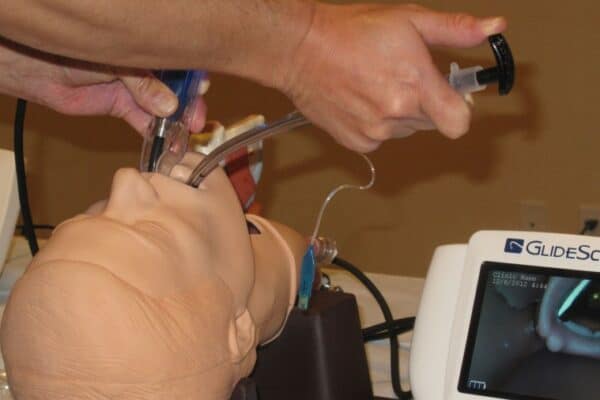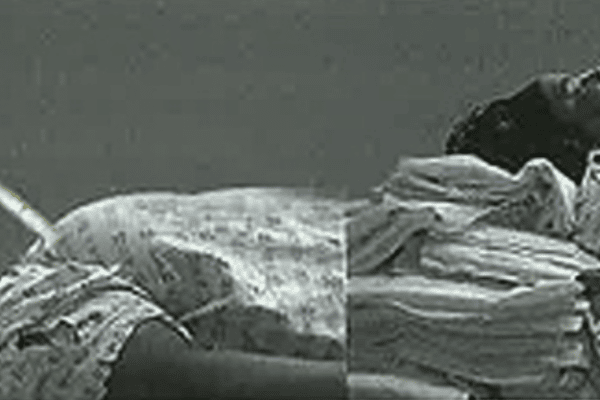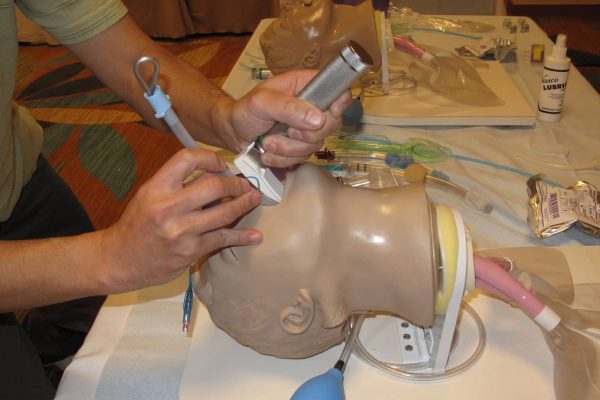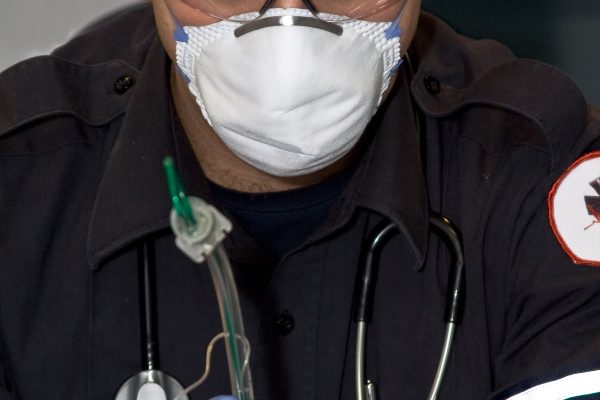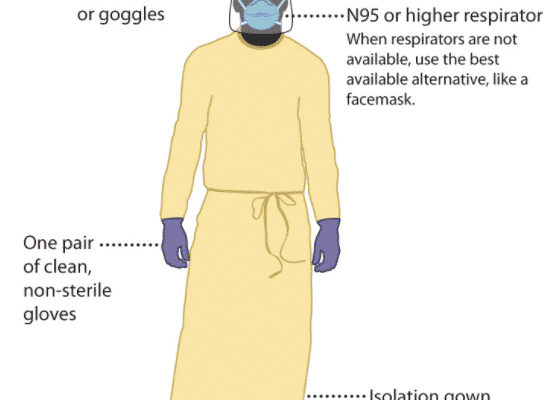A Glidescope is a device that is used for difficult airway management. A Glidescope is a video laryngoscope that usually provides better visualization of the larynx compared with direct laryngoscopy when you need to maintain cervical immobilization, have excessive oral secretions, or anticipate a very anterior larynx.
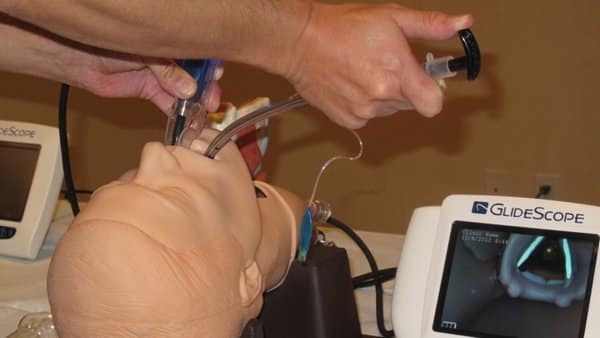
What you will Learn in the Glidescope Intubation Course
The Glidescope intubation course features two Glidescope machines to train students how to use video laryngoscopy for pediatric intubations and adult intubations. Other options for difficult airway management include stylet-guided intubations, laryngeal mask airway (LMA) placement, King tube placement, or fiberoptic intubations.
The HPC Hospitalist and Emergency Procedures course will teach you how to perform central line placement in addition to endotracheal intubation, stylet-guided intubations, laryngeal mask airway (LMA) placement, King tube placement, or fiberoptic intubations. ultrasound-guided peripheral IV access, arterial lines, POCUS exams (RUSH exams and E-FAST exams), thoracentesis, paracentesis, lumbar punctures, chest tube placement, pigtail catheter placement, needle thoracostomy, procedural sedation, and ventilator management.
Why you should choose us for your glidescope intubation course
Our Glidescope intubation training is a component of our live Hospitalist and Emergency Procedures CME course which teaches clinicians how to perform the 20 most essential procedures needed to work in the ER, ICU, and hospital wards.
Take your skills to the next level with our comprehensive Glidescope Intubation Course!
Glidescope Intubation Photos
More information about Glidescope Intubation
Glidescope intubation (also referred to as video laryngoscopy) is often compared to the direct laryngoscopy procedure. Some physicians enthusiastically support the use of Glidescope intubation / video laryngoscopy as the best practice in almost every case, but there is also evidence to support the use of direct laryngoscopy in certain circumstances.
Glidescope intubation was ultimately developed because some hospitalists and emergency physicians were not satisfied with direct laryngoscopy’s ability to provide a reliable and consistent view for endotracheal intubation.
Glidescope intubation’s advantages compared to direct laryngoscopy are numerous and include a higher success rate compared to direct layrngoscopy – this is particularly true in more challenging cases. Glidescope intubation is typically preferred in cases where you have to perform an awake intubation or a non-paralyzed intubation. Glidescope intubation also has a lower chance of an inadvertent esophageal intubation.
Direct laryngoscopy’s advantages include that the procedure is more easily performed in a variety of locations in which Glidescope equipment may be difficult to transport. Direct laryngoscopy may also be more practical if the procedure needs to be performed outdoors or in natural sunlight – the Glidescope monitor may experience some issue with glare from natural light.
Physicians who are very experienced and skilled in direct laryngoscopy may find the Glidescope method counterintuitive to what they’re accustomed to using with the direct method. Regardless of which method is preferred by a particular physician or midlevel provider, all clinicians practicing emergency medicine or hospital medicine need to be capable using either method.
If you’re a physician practicing emergency medicine, a nurse practitioner, physician assistant, or a medical student considering the emergency medicine field, then it is valuable to understand the various approaches and options available.
Do you have question about Glidescope intubation? We invite you to join the conversation by contacting a Hospital Procedures Consultants physician at www.Facebook.com/HospitalProcedures
Glidescope Intubation Course trains students in:
- Indications for a endotracheal intubation
- Considerations for oral endotracheal intubation
- Complications of endotracheal intubation
- Equipment for a Glidescope intubation
- Technique for adult and pediatric Glidescope intubation
- Options for Difficult Airway Management
- Times to consider video laryngoscopy over direct laryngoscopy
- Options for the Can’t Ventilate Can’t Intubate scenario
- Coding for endotracheal intubation
Glidescope Intubation Blogs
Clinical Pearls for Airway Management of Morbidly Obese Patients
Simulation Based Training Improves Airway Management Skills
Tips for Management and Bedside Procedures in Critically Ill Patients with COVID Pneumonia
Airway Management in COVID-positive Patients
Hospitalist and Emergency Procedures CME Courses Available
Register HERE 21 days before the course to SAVE $50-150 and get the following:
- 12 month online access to Online CME course, procedure video bundle, instructional posters
- Indefinite online access to PDFs of all course lectures, course handouts, and HPC Adult Critical Care and Emergency Drug Reference Drug
2024-05 Hospitalist and Emergency Procedures Course – Denver, CO (WEEKEND)
Sheraton Denver Downtown Hotel
July 20-21, 2024
Live Course & Online Course
(Saturday & Sunday)
Compare Registration Types
2024-04 Hospitalist and Emergency Procedures Course – Washington, DC (WEEKEND)
Washington Marriott Georgetown Hotel
June 8-9, 2024
Live Course & Online Course
(Saturday & Sunday)
Compare Registration Types
2024-05a Hospitalist and Emergency Procedures Course – Denver, CO (Saturday ONLY)
Sheraton Denver Downtown Hotel
July 20, 2024
Live Course & Online Course
(Saturday ONLY)
Compare Registration Types
2024-07 Hospitalist and Emergency Procedures Course – New Orleans, LA (WEEKEND)
Intercontinental New Orleans Hotel
October 19-20, 2024
Live Course & Online Course
(Saturday & Sunday)
Compare Registration Types
2024-04b Hospitalist and Emergency Procedures Course – Washington, DC (Sunday ONLY)
Washington Marriott Georgetown Hotel
June 9, 2024
Live Course & Online Course
(Sunday ONLY)
Compare Registration Types
2024-04a Hospitalist and Emergency Procedures Course – Washington, DC (Saturday ONLY)
Washington Marriott Georgetown Hotel
June 8, 2024
Live Course & Online Course
(Saturday ONLY)
Compare Registration Types
2024-03b Hospitalist and Emergency Procedures Course – Chicago, IL (Sunday ONLY)
Swissotel Chicago Hotel
April 28, 2024
Live Course & Online Course
(Sunday ONLY)
Compare Registration Types
2024-06 Hospitalist and Emergency Procedures Course – Seattle, WA (WEEKEND)
Crowne Plaza Seattle Downtown Hotel
September 7-8, 2024
Live Course & Online Course
(Saturday & Sunday)
Compare Registration Types
2024-08 Hospitalist and Emergency Procedures Course – San Antonio, TX (WEEKEND)
Courtyard Marriott San Antonio Riverwalk Hotel
November 16-17, 2024
Live Course & Online Course
(Saturday & Sunday)
Compare Registration Types
2024-03a Hospitalist and Emergency Procedures Course – Chicago, IL (Saturday ONLY)
Swissotel Chicago Hotel
April 27, 2024
Live Course & Online Course
(Saturday ONLY)
Compare Registration Types




